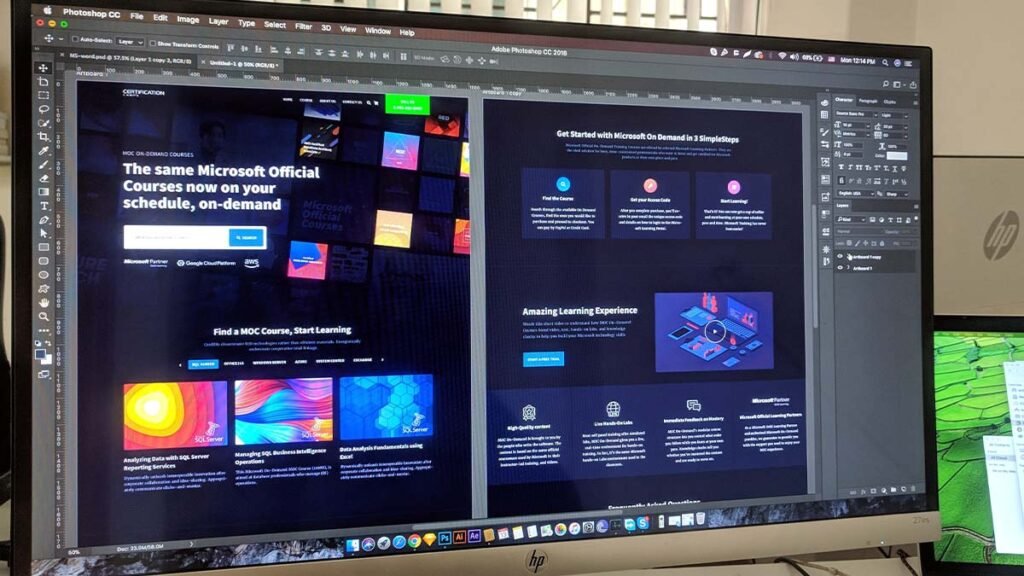The allure of the digital age beckons. With the rise of internet businesses and the increasing demand for eye-catching websites, web design has emerged as a promising career. A unique blend of aesthetics, technology, and user-centric design, web designing is not just about creating websites; it’s about crafting experiences.
Yet, embarking on this journey can be daunting. Many students find themselves wondering where to begin, often wishing someone could just “write my essay for me” on the ins and outs of web designer education. If you’re one such student, fret not! This guide aims to shed light on your path to a vibrant, creative career in web design.
Understanding the Basics: What Web Design Entails
At its core, web design is about creating the look, feel, and structure of a website. It’s the beautiful layout you admire, the intuitive navigation you appreciate, and the responsive design that makes browsing a pleasure regardless of your device.
Visual Aesthetics: A web designer must have a keen eye for aesthetics. From choosing the right color palette to crafting coherent and captivating layouts, your visual designs form the first impression for users. Stay updated with design trends, but also understand the timeless principles that ensure your designs remain fresh.
Technical Know-How: While you’re not expected to be a full-blown developer, a basic understanding of HTML, CSS, and even a touch of JavaScript can go a long way. Not only does this knowledge allow you to understand what’s feasible, but it also facilitates smoother communication with developers.
User Experience (UX) Principles: Beyond aesthetics and coding basics, web design is about the user. Knowing how users interact with digital platforms, anticipating their needs, and crafting a seamless experience is paramount. Familiarize yourself with user behavior patterns and feedback loops to refine and iterate your designs.

Carving Your Educational Path
So, you’re intrigued by web design and itching to dive in. Where do you start? Fortunately, there are multiple pathways to gain the skills and knowledge required.
Formal Education: Consider pursuing a degree in web design or a related field like graphic design or multimedia arts. These programs often offer comprehensive curriculums that cover both theory and hands-on practice. Moreover, they provide valuable networking opportunities, allowing you to interact with peers and industry professionals.
Online Courses & Bootcamps: For those who prefer flexibility or are looking to transition from another field, online platforms offer an array of courses, ranging from the basics to advanced topics. Bootcamps, in particular, are intensive, focused programs designed to get you job-ready in a shorter span.
Self-Study & Practice: The digital age blesses us with a plethora of resources. Blogs, forums, YouTube tutorials, and design platforms offer vast learning materials. However, remember, in design, practice is crucial. Start by creating mock projects or even redesigning your favorite websites for fun!
Building a Portfolio: Showcasing Your Skill
Having skills is one thing; proving them to potential employers or clients is another. A portfolio is your ticket to showcasing your talent, your style, and your versatility.
Quality Over Quantity: Instead of cramming every little project, choose those that best represent your range and depth. A well-curated portfolio with a few standout pieces is more effective than a vast, inconsistent collection.
Document Your Process: For each project, don’t just showcase the end result. Walk the viewer through your thought process, sketches, iterations, and feedback incorporated. This demonstrates professionalism and a methodical approach.
Keep It Updated: Design is ever-evolving, and so should your portfolio. As you hone your skills and work on newer projects, make sure to update your portfolio. This ensures you’re always putting your best foot forward.
The Importance of Soft Skills in Web Design
While technical prowess and creativity are the pillars of web design, the significance of soft skills cannot be overstated. These interpersonal attributes can set you apart in a competitive market and enhance your effectiveness in team projects.
Communication is Key: In web design, you’re seldom working in isolation. Whether it’s collaborating with developers, understanding client requirements, or presenting your designs, clear communication is paramount. It’s not only about conveying your ideas but also about active listening and ensuring all stakeholders are on the same page.
Problem-Solving Prowess: Design challenges will arise, be it a client’s shifting requirements or a user interface issue. Your ability to think on your feet, innovate solutions, and adapt is invaluable. Every problem presents an opportunity for growth, so embrace them with an analytical mindset.
Time Management & Organization: With multiple projects, tight deadlines, and ever-evolving requirements, your organizational skills become crucial. Crafting a website design is not a linear process; it requires juggling various tasks effectively. Setting priorities, scheduling, and adhering to deadlines ensures you remain productive and meet client expectations.
Networking: The Unsung Hero of Your Career
The world of web design, like many creative industries, thrives on connections. Networking can unlock doors to opportunities, collaborations, and continuous learning.
Attend Workshops & Conferences: Not only do these events provide knowledge and skill-building sessions, but they’re also fantastic for networking. Mingle, exchange contacts, and stay in touch with professionals who could be potential employers, mentors, or collaborators.
Engage in Online Communities: Websites like Behance, Dribbble, or even design-focused subreddits are bustling with designers sharing their work, seeking feedback, and discussing the latest trends. Being active in these communities amplifies your presence and connects you with like-minded individuals.
Seek Mentorship: If you admire a designer’s work or resonate with their philosophy, reach out! A mentor can provide guidance, critique, and insights you might not gain elsewhere. It’s a two-way street – while they offer their expertise, your fresh perspective can also be enlightening for them.
Conclusion
Embarking on a journey in web design promises a blend of creativity and tech-savviness. It’s a realm where innovation meets functionality and art meets coding. As you step into this vibrant world, remember that continuous learning and adaptation are the names of the game. Keep your passion ignited, stay curious, and always strive for growth. The digital canvas awaits your unique touch.




